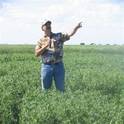
Long-term management practices are needed to increase dryland C storage and improve soil quality. We evaluated the 21-yr effects of combinations of tillage and cropping sequences on dryland crop biomass (stems + leaves) returned to the soil, residue C, and soil C fractions at the 0- to 20-cm depth in a Dooley sandy loam (fine-loamy, mixed, frigid, Typic Argiborolls) in eastern Montana. Treatments were no-till continuous spring wheat (Triticum aestivum L.) (NTCW), spring-tilled continuous spring wheat (STCW), fall- and spring-tilled continuous spring wheat (FSTCW), fall- and spring-tilled spring wheat–barley (Hordeum vulgare L.) (1984–1999) followed by spring wheat–pea (Pisum sativum L.) (2000–2004) (FSTW-B/P), and spring-tilled spring wheat–fallow (STW-F). Carbon fractions were soil organic C (SOC), soil inorganic C (SIC), particulate organic C (POC), microbial biomass C (MBC), and potential C mineralization (PCM). Mean crop biomass was 53 to 66% greater in NTCW, STCW, FSTCW, and FSTW-B/P than in STW-F. Soil surface residue amount and C content in 2004 were 46 to 60% greater in NTCW and FSTCW than in STW-F. As a result, soil C fractions at 0 to 20 cm were 23 to 141% greater in all other treatments than in STW-F due to increased C input. At 0 to 5 cm, SOC, SIC, POC, and PCM were greater in NTCW than in FSTW-B/P. At 5 to 20 cm, POC was greater in NTCW than in FSTW-B/P and PCM was greater in STCW than in FSTCW. Long-term reduced tillage with continuous nonlegume cropping increased dryland crop biomass, residue and soil C storage, and soil quality by increasing microbial biomass and activities compared with a conventional system such as STW-F.
Available at: http://works.bepress.com/andrew_lenssen/8/
